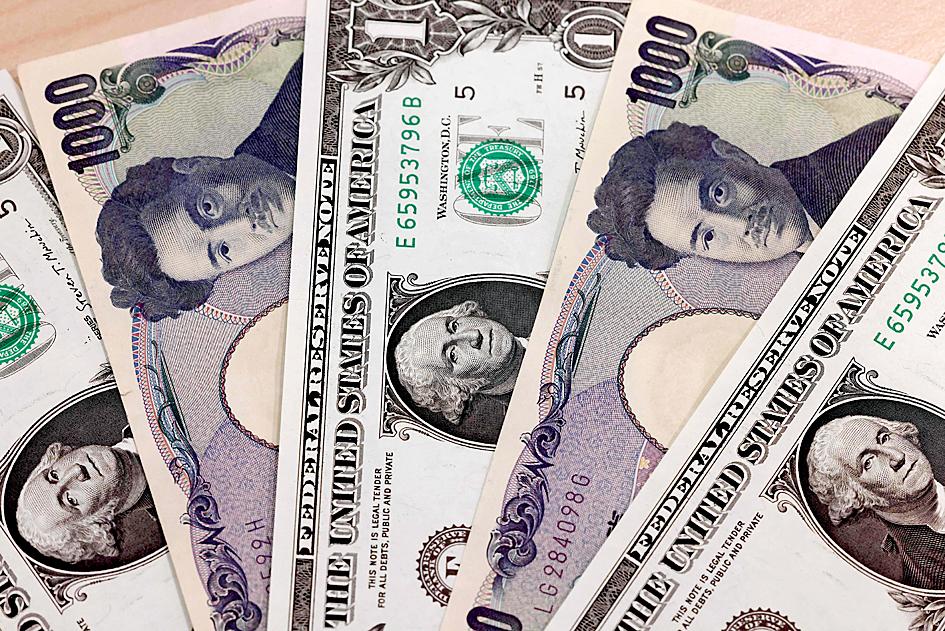The US dollar on Friday edged higher against a basket of currencies, after a better-than-expected US employment report pointed to a tight labor market that could lead the US Federal Reserve to go with interest rate hikes.
Nonfarm payrolls increased by 390,000 jobs last month, the US Department of Labor said in its closely watched employment report on Friday.
Economists polled by Reuters had forecast payrolls increasing by 325,000 jobs.

Photo: AFP
The US Dollar Currency Index, which tracks the greenback against six other major currencies, was 0.34 percent higher at 102.17, gaining 0.49 percent from a week earlier.
The better-than-anticipated job gain is another sign the economy is still strong, while wage growth is beginning to moderate amid a rebound in the labor force, Capital Economics senior economist Michael Pearce wrote in a note.
“With wage growth still running well above rates that are consistent with the Fed’s 2 percent inflation target, however, that won’t stop the Fed from continuing to raise rates by 50 basis points at the next meeting or two,” Pearce wrote.
The Fed has raised interest rates by three quarters of a percentage point this year, and most Fed policymakers back increasing interest rates another half of a percentage point at each of their next two meetings.
Calling high inflation the US central bank’s “number one challenge,” Fed Vice Chairwoman Lael Brainard on Thursday said she backs at least a couple more half-percentage-point interest rate hikes, with more on tap if price pressures fail to ease.
Investors have mixed views on the greenback, which is still close to two-decade highs against a basket of peers.
George Saravelos, global head of forex research at Deutsche Bank, said the US dollar is “pricing a safe-haven risk premium that is so extreme it rarely has persisted over time and is now in the process of unwinding.”
Bullish analysts say that the Fed’s tightening cycle is based on a sturdier growth story than Europe’s, especially after the Russian oil embargo, which might hurt the eurozone economy.
As Taiwan celebrated the Dragon Boat Festival holiday on Friday, the New Taiwan dollar last closed down NT$0.118 at NT$29.388 against the greenback on Thursday, declining 0.13 percent from Friday last week.
The US dollar rose 0.5 percent to a more than three-week high of ¥130.46, with the Japanese currency not far from the two-decade low touched last month as the Bank of Japan (BOJ) stuck to its super-low interest rate policy stance.
BOJ Governor Haruhiko Kuroda — who has said the bank would not roll back its monetary stimulus as the recent rise in inflation was driven mostly by raw commodity costs and was likely temporary — on Friday said it was undesirable for prices to rise too much when household income growth remains weak.
Additional reporting by staff writer

The US dollar was trading at NT$29.7 at 10am today on the Taipei Foreign Exchange, as the New Taiwan dollar gained NT$1.364 from the previous close last week. The NT dollar continued to rise today, after surging 3.07 percent on Friday. After opening at NT$30.91, the NT dollar gained more than NT$1 in just 15 minutes, briefly passing the NT$30 mark. Before the US Department of the Treasury's semi-annual currency report came out, expectations that the NT dollar would keep rising were already building. The NT dollar on Friday closed at NT$31.064, up by NT$0.953 — a 3.07 percent single-day gain. Today,

‘SHORT TERM’: The local currency would likely remain strong in the near term, driven by anticipated US trade pressure, capital inflows and expectations of a US Fed rate cut The US dollar is expected to fall below NT$30 in the near term, as traders anticipate increased pressure from Washington for Taiwan to allow the New Taiwan dollar to appreciate, Cathay United Bank (國泰世華銀行) chief economist Lin Chi-chao (林啟超) said. Following a sharp drop in the greenback against the NT dollar on Friday, Lin told the Central News Agency that the local currency is likely to remain strong in the short term, driven in part by market psychology surrounding anticipated US policy pressure. On Friday, the US dollar fell NT$0.953, or 3.07 percent, closing at NT$31.064 — its lowest level since Jan.

Hong Kong authorities ramped up sales of the local dollar as the greenback’s slide threatened the foreign-exchange peg. The Hong Kong Monetary Authority (HKMA) sold a record HK$60.5 billion (US$7.8 billion) of the city’s currency, according to an alert sent on its Bloomberg page yesterday in Asia, after it tested the upper end of its trading band. That added to the HK$56.1 billion of sales versus the greenback since Friday. The rapid intervention signals efforts from the city’s authorities to limit the local currency’s moves within its HK$7.75 to HK$7.85 per US dollar trading band. Heavy sales of the local dollar by

The Financial Supervisory Commission (FSC) yesterday met with some of the nation’s largest insurance companies as a skyrocketing New Taiwan dollar piles pressure on their hundreds of billions of dollars in US bond investments. The commission has asked some life insurance firms, among the biggest Asian holders of US debt, to discuss how the rapidly strengthening NT dollar has impacted their operations, people familiar with the matter said. The meeting took place as the NT dollar jumped as much as 5 percent yesterday, its biggest intraday gain in more than three decades. The local currency surged as exporters rushed to